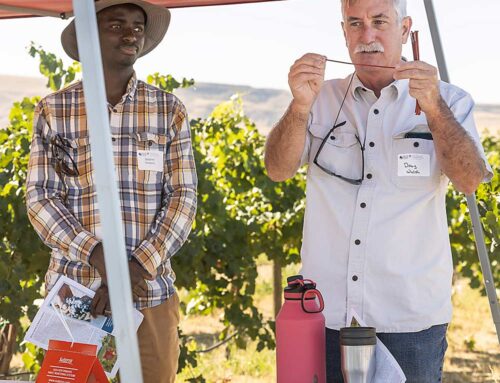
Australian Kym Green trains his sweet cherry trees to the KGB (Kym Green’s Bush) system. His pedestrian-style orchard is easily pruned and harvested without ladders.
Cherry orchardists worldwide use different training systems, varieties, and rootstocks, and have different ways of doing things, but those striving for excellent quality and yields all pay attention to one thing—light management. “Light management is the key to high-quality, high-yielding fruit,” said Kym Green of Ellimatta Orchards in Lenswood, South Australia.
Green shared his “Down Under” cherry-growing philosophy with fellow orchardists from around the globe who attended a high-density cherry short course in Pasco, Washington. The seminar, sponsored by the International Dwarf Fruit Tree Association, included talks as well as field tours of cherry orchards in Washington and Oregon. How do growers manage light for large fruit? Green answered that light management and pruning rules are the same for any training system.
“Diameter pruning means that you cut the biggest limbs. Remove the large limbs at the top of the tree and make side limbs into side limbs.” He explained that “chunk” pruning (taking out big limbs) is necessary to maintain proper balance of light within a tree canopy. Taking out big chunks removes the tree’s sink for nutrients and puts a “big light pocket in the tree, allowing a place for renewal.”
Thumb-size caliper of limbs is best, he added. Lateral branches that are headed downward should be removed. “When a limb goes below horizontal, it loses calcium, and you’ll get softer fruit. Calcium can be four times below minimum levels on pendulant wood or on old fruiting spurs.”
Growers need to be able to identify big wood and bad wood, Green suggested. “A bad limb is a bad limb. You need to totally remove it.” Good fruiting wood is of small caliper, he explained, and is upright, with potential for big leaf size and a good leaf-to-fruit ratio. Green has developed his own cherry training system which he calls the KGB or Kym Green’s Bush.
His planting density is around 700 trees per acre because he has a double set of trees down each row, but it could also be planted in single rows, with around 400 trees per acre. “It’s nothing like the Spanish bush training system,” he said, adding that tree size is easily managed and the pruning techniques are repeatable and teachable. “Trees are the same size year in and year out.”
He described the KGB system as a pedestrian orchard with trees open in the center. Trees are planted 7 feet apart with 14 feet between the rows. Tree height is 8 feet. “Diameter pruning is the key to systematic pruning,” Green said. Removing the larger diameter branches makes pruning decisions easy. “The number-one enemy of good tree health is big wood. It’s a sponge for nutrients.”
With the KGB system, trees are pruned to have 30 fruiting branches in the second leaf. In the third leaf, the largest limb in each quarter of the tree is stub cut, thereby removing the largest limbs from the tree. Trees begin to produce fruit by the fourth leaf and reach full production in the fifth leaf.
The only permanent structure in the KGB system is the base of the tree, he noted. Uniformity of the training system makes every tree the same, and that makes it easier to prune and makes farming easy, he said. “Good pruning, no matter what the system, is the key to profitability.”






Leave A Comment